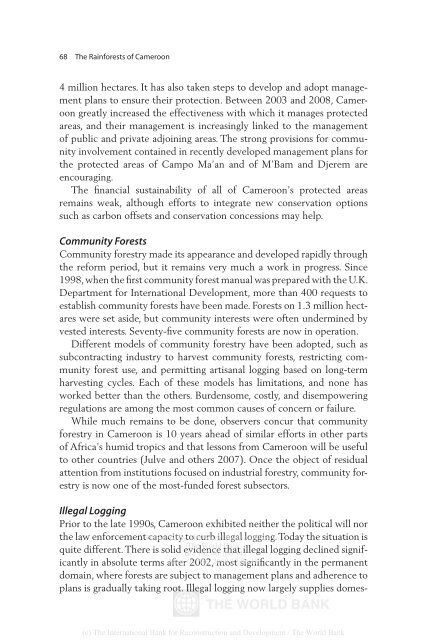The Rainforests of Cameroon - PROFOR
The Rainforests of Cameroon - PROFOR
The Rainforests of Cameroon - PROFOR
- No tags were found...
Create successful ePaper yourself
Turn your PDF publications into a flip-book with our unique Google optimized e-Paper software.
68 <strong>The</strong> <strong>Rainforests</strong> <strong>of</strong> <strong>Cameroon</strong>4 million hectares. It has also taken steps to develop and adopt managementplans to ensure their protection. Between 2003 and 2008, <strong>Cameroon</strong>greatly increased the effectiveness with which it manages protectedareas, and their management is increasingly linked to the management<strong>of</strong> public and private adjoining areas. <strong>The</strong> strong provisions for communityinvolvement contained in recently developed management plans forthe protected areas <strong>of</strong> Campo Ma’an and <strong>of</strong> M’Bam and Djerem areencouraging.<strong>The</strong> financial sustainability <strong>of</strong> all <strong>of</strong> <strong>Cameroon</strong>’s protected areasremains weak, although efforts to integrate new conservation optionssuch as carbon <strong>of</strong>fsets and conservation concessions may help.Community ForestsCommunity forestry made its appearance and developed rapidly throughthe reform period, but it remains very much a work in progress. Since1998, when the first community forest manual was prepared with the U.K.Department for International Development, more than 400 requests toestablish community forests have been made. Forests on 1.3 million hectareswere set aside, but community interests were <strong>of</strong>ten undermined byvested interests. Seventy-five community forests are now in operation.Different models <strong>of</strong> community forestry have been adopted, such assubcontracting industry to harvest community forests, restricting communityforest use, and permitting artisanal logging based on long-termharvesting cycles. Each <strong>of</strong> these models has limitations, and none hasworked better than the others. Burdensome, costly, and disempoweringregulations are among the most common causes <strong>of</strong> concern or failure.While much remains to be done, observers concur that communityforestry in <strong>Cameroon</strong> is 10 years ahead <strong>of</strong> similar efforts in other parts<strong>of</strong> Africa’s humid tropics and that lessons from <strong>Cameroon</strong> will be usefulto other countries (Julve and others 2007). Once the object <strong>of</strong> residualattention from institutions focused on industrial forestry, community forestryis now one <strong>of</strong> the most-funded forest subsectors.Illegal LoggingPrior to the late 1990s, <strong>Cameroon</strong> exhibited neither the political will northe law enforcement Delivered capacity by to <strong>The</strong> curb World illegal Bank e-library logging. to: Today the situation is<strong>The</strong> World Bankquite different. <strong>The</strong>re is solid evidence IP : 192.86.100.34 that illegal logging declined significantlyin absolute terms after Mon, 09 2002, Nov 2009 most 17:06:18 significantly in the permanentdomain, where forests are subject to management plans and adherence toplans is gradually taking root. Illegal logging now largely supplies domes-(c) <strong>The</strong> International Bank for Reconstruction and Development / <strong>The</strong> World Bank
















